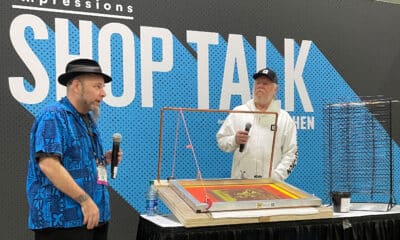Prepress & Screen Making
Published
22 years agoon
You may be ready to take on jobs with long run lengths, but are your screens? Coudray walks through screen and stencil preparation, identifying techniques for producing accurate and durable screens that will last beyond 100,000 impressions.
There comes a point for all printers when they land the big kahuna, a monster job that eclipses any order they’ve run before in terms of run length. I can’t say exactly how big this job is, but it is an order of magnitude above what is normal for the operation–it might be 5000, 50,000, or 150,000 pieces.
You may be ready to take on jobs with long run lengths, but are your screens? Coudray walks through screen and stencil preparation, identifying techniques for producing accurate and durable screens that will last beyond 100,000 impressions.
There comes a point for all printers when they land the big kahuna, a monster job that eclipses any order they’ve run before in terms of run length. I can’t say exactly how big this job is, but it is an order of magnitude above what is normal for the operation–it might be 5000, 50,000, or 150,000 pieces.
Orders of this size create many challenges for the production manager. One of the most demanding is making production screens that can hold up to these extra long runs. This month, I would like to discuss how to make such screens and the techniques that will help to keep them on press in excess of 100,000 impressions.
For screens to hold up over very long runs, they must resist abrasion, ink penetration, and emulsion breakdown, all while maintaining edge definition. They must hold up to repeated wipedowns and press washes. And registration should be rock solid over the entire run, with no change in image size or shape.
Many printers never have had to worry about these issues, because their runs are short enough that they never experience any of the associated weak points. For our purposes here, we’ll consider a long run as anything over 5,000 and less than 150,000 prints. Our goal is to create screens that will last the entire length of the run with no loss of print quality.
It starts with mesh
The journey begins with properly tensioned mesh. We should not use screens with less than 22 N/cm of tension. Anything lower than this offers too much elastic distortion, which will eventually lead to failure. Depending on mesh type, brand, thread diameter, weave, and mesh count, printing tensions should range between 25-45 N/cm. Lower tensions usually result in higher off-contact distances on press, which ultimately lead to excess squeegee pressure and premature screen fatigue and failure.
A stable mesh is critical. For this reason, we should avoid using new mesh on a long-run. Virgin mesh is simply not stable enough to make a satisfactory long-run screen. I prefer screens that have been cycled and retensioned at least four times. This allows for all cold flow and knuckle binding to stabilize. With a stable screen, the image will not change size on press, and the ink transfer will be consistent over the entire run.
Proper degreasing and neutralization of the cleansing agent on the mesh is also important. The thread surface must be in optimum condition to accept the emulsion. Improperly degreased screens or mesh with ghost images will lead to premature failure on press.
Choosing the right emulsion
For long-run performance, nothing beats high-solids direct emulsion. I prefer the dual-cure (photopolymer/diazo) variety. The dual-cures give the best combination of edge definition and complete exposure conversion. High-solids emulsions resist shrinking during drying, leaving ample resin to resist squeegee, flood, and substrate abrasion. Coating technique is very important. The idea is to create ideal emulsion-over-mesh (EOM) buildup. The exact EOM measurement will depend on substrate and ink type. Printers using UV inks may need only 8-12 microns, while a high-density textile printer may require 700 microns.
The higher the EOM requirement, the more likely you will need to employ a capillary/direct (also known as direct/indirect) stencil system. Regardless of whether you use direct emulsion or capillary film, it is important that the squeegee side of the screen be completely encapsulated with emulsion. The greater the encapsulation, the longer the screen will resist the constant abrasion of the squeegee and floodbar.
Drying and exposure will also have a huge bearing on the durability of your screen. Coated screens need to be completely dry before exposure. This means that the internal humidity of the dry emulsion should be the same as the relative humidity of the drying area (about 40%). If you dry screens in an area with humidity below 40%, you run the risk of brittle emulsion that will prematurely crack and breakdown on press. Humidity above 60% will interfere with the proper exposure, effectively canceling the formation of long molecular chains (one major source of emulsion toughness and strength).
Ensuring proper exposure
Complete exposure is critical. A low-output UV light source will not get the job done. Long-run screens require the efficiency of metal-halide or trimetal-halide lamps. The rich UV output of these bulbs, coupled with their high watt density, result in complete polymerization of the diazo/photopolymer sensitizer and resin of the emulsion. The long molecular bonds that result are very tough and will hold up to much abuse.
The length of exposure is also critical. Any premature or underexposure of the emulsion will cause the thin emulsion coating on the squeegee side to wash off. When this happens, the surface is now extremely vulnerable to squeegee/flood friction and ink/solvent penetration. These factors will cause a screen to fail quickly, sometimes in less than 500 impressions.
Applying blockout
With the screen washed out, blotted (or vacuumed,) and dried, it is time to apply blockout. Two very effective application techniques can dramatically lengthen the life of the screen. The first is to use emulsion as the blockout agent, which results in a very strong final stencil.
Technique number one uses sensitized emulsion as the blockout. We card on the emulsion as we would normal blockout. Next we apply double and triple thickness coatings up and down the frame where the ends of the squeegee and floodbar will track. We are reinforcing these typical failure points to increase resistance. And we must make sure to dry the screen in the yellow safelight of the coating room–it is important to have a sensitized image when the emulsion is dry.
When the emulsion is completely dry, we take the screen outside and post expose it to the sun for a minimum of 2 min. The longer the screen is left outside, the better off we will be. If we cannot use the sun due to weather or climate, we can post-expose the screen for a minimum of 300% of the normal exposure in the exposure unit. These post exposures will greatly strengthen and improve the friction resistance of the screen.
Technique number two is a modification of the first. After we washout and dry the screen, we recoat the inside and outside using a two-over-two, wet-on-wet coating approach. This will fill in all of the open mesh that we just washed out and it will apply a thin layer of emulsion on the squeegee and print side of the screen. We then dry as we normally would.
Now it is time for our second exposure. For the second exposure we will have had the art department make a solid mask of the image area that is exactly 1/16 in. (1.5 mm) bigger than the original image. It will be solid black. We register this mask to the screen and make a second exposure at 300% of the original exposure, then wash out the screen.
When the washout is complete, we will have a double thick emulsion over all the nonimage areas of the screen. All pinholes and weak spots will have received a double reinforcement of emulsion. And the longer exposure will assure that all available sensitizer will cross link with available resin.
Finishing touches
Taping the screen is important as well. It’s wise to pay the extra price and use the pressure-sensitive tapes designed for this purpose. These tapes are usually 2 or 3 in. wide and will cost anywhere from $6-15 per roll. As expensive as they are, the adhesive is very aggressive and will not break down from constant immersion in the ink. We run two parallel strips of tape down the length of the frame 1/2 in. inside of the squeegee and floodbar path. This will form a friction track that the squeegee and floodbar can run on. The tips of the floodbar and squeegee are the areas where the highest abrasion occurs. By having the squeegee and flood run on the tape, we greatly reduce the friction on the mesh.
We continue the taping by duplicating the squeegee/flood track on the print side of the screen. If either the squeegee or flood were to work though the emulsion on the inside of the frame, this layer of tape will delay the emulsion breakdown.
When taping the screen, we should avoid applying tape to the areas of the screen where the squeegee and floodbar change over. This is a real problem area in the screen because tremendous, aggressive friction is applied in exactly the same spot over and over. If we put tape down to minimize this (a logical approach), we will quickly discover that the tape will be pulled into the image area by the squeegee. It is better to use extra emulsion, as described previously, to combat this problem. The friction tracks are not subject to this problem because the length of tape is perpendicular to the squeegee/floodbar motion.
Register marks can also be a problem for textile printers. Once the job is set up, the marks are usually taped out. For long runs, this is unacceptable. A better approach is to use water-soluble blockout. We card it over the marks, let them dry, and then tape the print side of the screen. If we need to reregister, we simply remove the tape, wipe out the marks with a damp cloth, and make our test print. If we do not follow this approach, ink will find a channel under the tape, working itself out onto the substrate. This may take quite some time, but it will eventually happen.
As aggressive as these methods sound, screens created using these techniques are no more difficult to reclaim than normal screens. The combination of higher-emulsion coating and complete exposure, coupled with minimum squeegee pressure and off-contact, will allow for screens that can stand up to tens of thousands of impressions without even breathing hard.
Long-run performance
Long runs pose many special challenges. When screens begin to breakdown and eventually rip on press, the economic consequences are huge. This is multiplied when we are using a multicolor press and screens fail at faster rates. But by using the methods outlined here, not only will screens last much longer, but the stencils will perform at optimal levels throughout the entire run.

Subscribe

Magazine
Get the most important news
and business ideas from Screenprinting Magazine.
Most Popular
-

 Columns1 month ago
Columns1 month ago8 Marketing Mistakes Not to Make When Promoting Your Screen Printing Services Online
-

 Press Releases1 month ago
Press Releases1 month agoSports Inspired Clothing Market: The Influence of Sports on Fashion Forward Looks
-

 Editor's Note1 month ago
Editor's Note1 month agoLivin’ the High Life
-

 Marshall Atkinson1 month ago
Marshall Atkinson1 month agoHow to Create a Winning Culture in Your Screen-Printing Business
-

 Press Releases4 weeks ago
Press Releases4 weeks agoHope Harbor to Receive Donation from BlueCotton’s 2024 Mary Ruth King Award Recipient
-

 Case Studies1 month ago
Case Studies1 month agoScreen Printing for Texture and Depth
-

 News & Trends2 months ago
News & Trends2 months agoWhat Are ZALPHAS and How Can You Serve Them in Your Print Business?
-

 Headlines1 month ago
Headlines1 month agoLive Poster Printing Raises $30K for Charity




